Attached files
| file | filename |
|---|---|
| EX-99.1 - EXHIBIT 99.1 - Bank7 Corp. | brhc10013700_ex99-1.htm |
| 8-K - 8-K - Bank7 Corp. | brhc10013700_8k.htm |
Exhibit 99.2
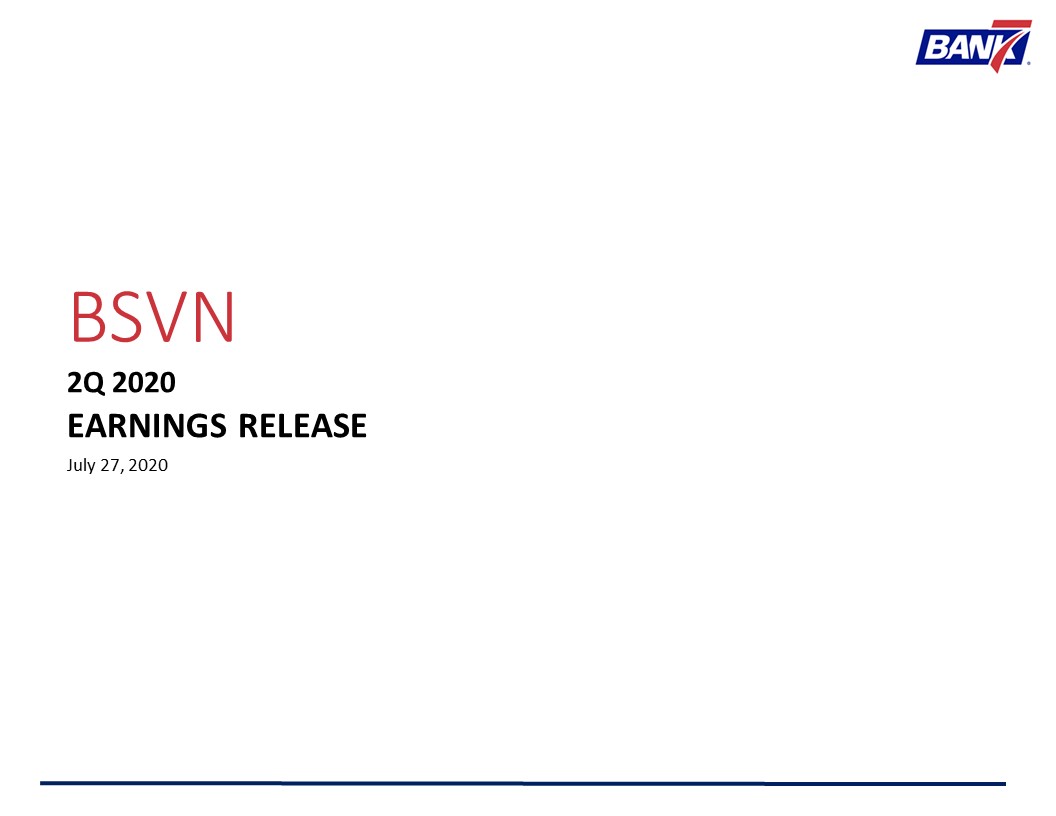
BSVN 2Q 2020EARNINGS RELEASEJuly 27, 2020
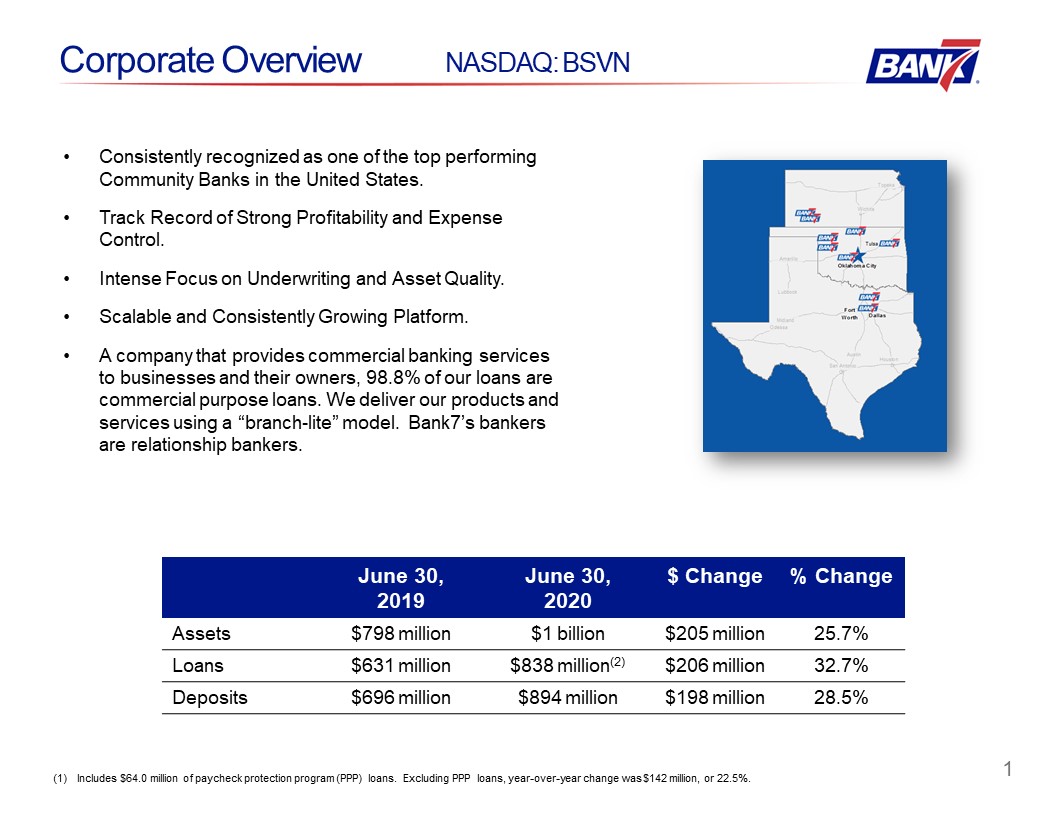
1 Corporate Overview NASDAQ: BSVN June 30, 2019 June 30, 2020 $ Change % Change Assets $798
million $1 billion $205 million 25.7% Loans $631 million $838 million(2) $206 million 32.7% Deposits $696 million $894 million $198 million 28.5% Consistently recognized as one of the top performing Community Banks in the United
States.Track Record of Strong Profitability and Expense Control.Intense Focus on Underwriting and Asset Quality.Scalable and Consistently Growing Platform.A company that provides commercial banking services to businesses and their owners,
98.8% of our loans are commercial purpose loans. We deliver our products and services using a “branch-lite” model. Bank7’s bankers are relationship bankers. Includes $64.0 million of paycheck protection program (PPP) loans. Excluding PPP
loans, year-over-year change was $142 million, or 22.5%.
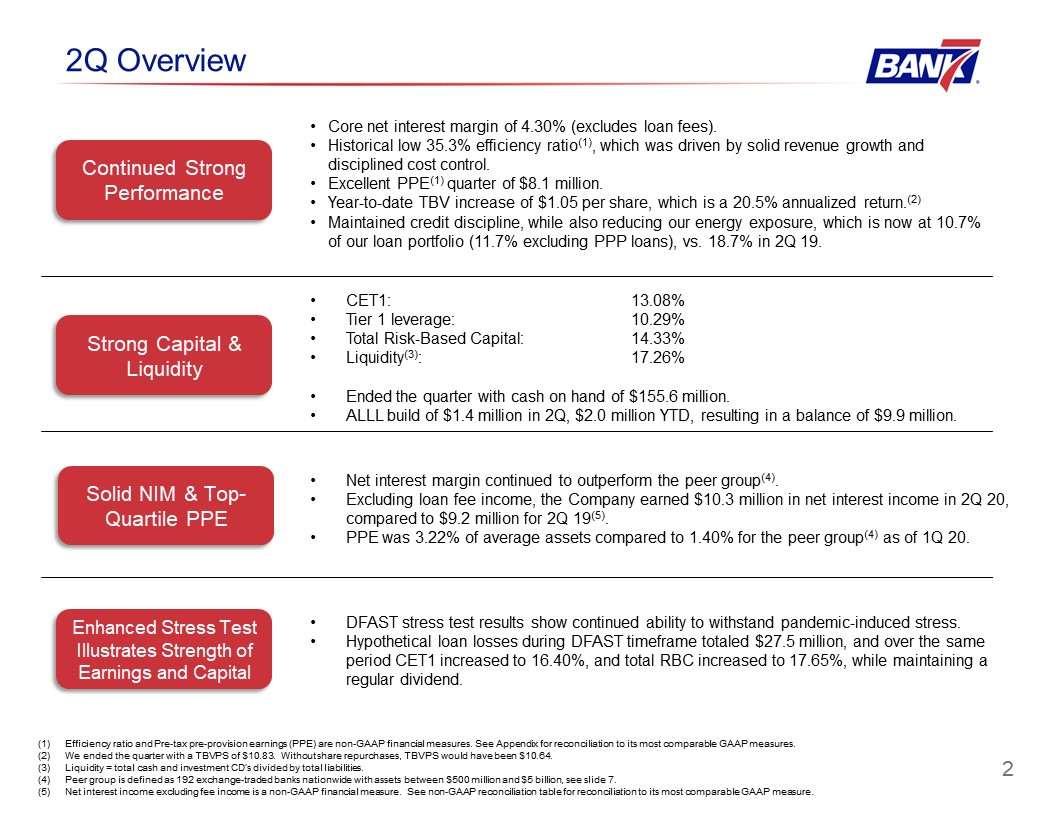
2 2Q Overview Solid NIM & Top-Quartile PPE Net interest margin continued to outperform the peer
group(4).Excluding loan fee income, the Company earned $10.3 million in net interest income in 2Q 20, compared to $9.2 million for 2Q 19(5).PPE was 3.22% of average assets compared to 1.40% for the peer group(4) as of 1Q 20. Continued
Strong Performance Core net interest margin of 4.30% (excludes loan fees).Historical low 35.3% efficiency ratio(1), which was driven by solid revenue growth and disciplined cost control.Excellent PPE(1) quarter of $8.1 million.Year-to-date
TBV increase of $1.05 per share, which is a 20.5% annualized return.(2)Maintained credit discipline, while also reducing our energy exposure, which is now at 10.7% of our loan portfolio (11.7% excluding PPP loans), vs. 18.7% in 2Q 19.
Enhanced Stress Test Illustrates Strength of Earnings and Capital DFAST stress test results show continued ability to withstand pandemic-induced stress.Hypothetical loan losses during DFAST timeframe totaled $27.5 million, and over the
same period CET1 increased to 16.40%, and total RBC increased to 17.65%, while maintaining a regular dividend. Efficiency ratio and Pre-tax pre-provision earnings (PPE) are non-GAAP financial measures. See Appendix for reconciliation to its
most comparable GAAP measures.We ended the quarter with a TBVPS of $10.83. Without share repurchases, TBVPS would have been $10.64.Liquidity = total cash and investment CD’s divided by total liabilities. Peer group is defined as 192
exchange-traded banks nationwide with assets between $500 million and $5 billion, see slide 7.Net interest income excluding fee income is a non-GAAP financial measure. See non-GAAP reconciliation table for reconciliation to its most
comparable GAAP measure. Strong Capital & Liquidity CET1: 13.08%Tier 1 leverage: 10.29%Total Risk-Based Capital: 14.33%Liquidity(3): 17.26% Ended the quarter with cash on hand of $155.6 million.ALLL build of $1.4 million in 2Q, $2.0
million YTD, resulting in a balance of $9.9 million.
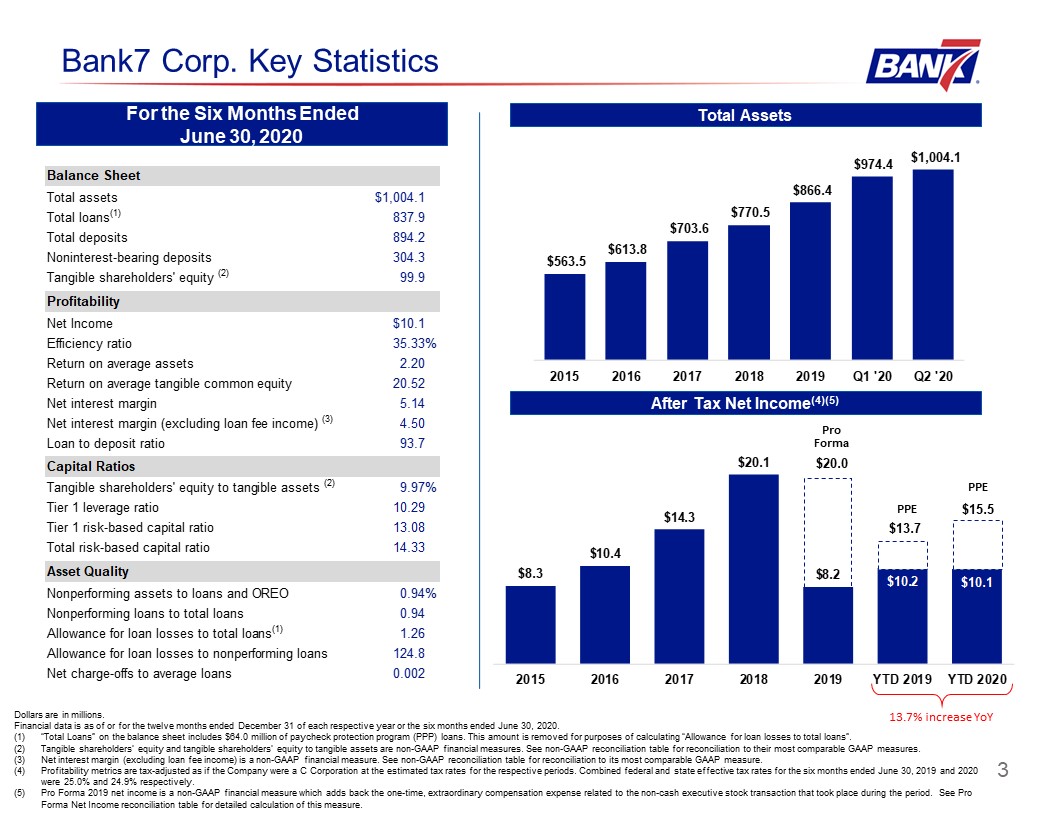
13.7% increase YoY Bank7 Corp. Key Statistics For the Six Months EndedJune 30, 2020 After Tax Net
Income(4)(5) Dollars are in millions. Financial data is as of or for the twelve months ended December 31 of each respective year or the six months ended June 30, 2020.“Total Loans” on the balance sheet includes $64.0 million of paycheck
protection program (PPP) loans. This amount is removed for purposes of calculating “Allowance for loan losses to total loans”.Tangible shareholders’ equity and tangible shareholders’ equity to tangible assets are non-GAAP financial measures.
See non-GAAP reconciliation table for reconciliation to their most comparable GAAP measures.Net interest margin (excluding loan fee income) is a non-GAAP financial measure. See non-GAAP reconciliation table for reconciliation to its most
comparable GAAP measure.Profitability metrics are tax-adjusted as if the Company were a C Corporation at the estimated tax rates for the respective periods. Combined federal and state effective tax rates for the six months ended June 30, 2019
and 2020 were 25.0% and 24.9% respectively. Pro Forma 2019 net income is a non-GAAP financial measure which adds back the one-time, extraordinary compensation expense related to the non-cash executive stock transaction that took place during
the period. See Pro Forma Net Income reconciliation table for detailed calculation of this measure. Total Assets 3 Pro Forma $20.0 $13.7 $15.5 PPE PPE
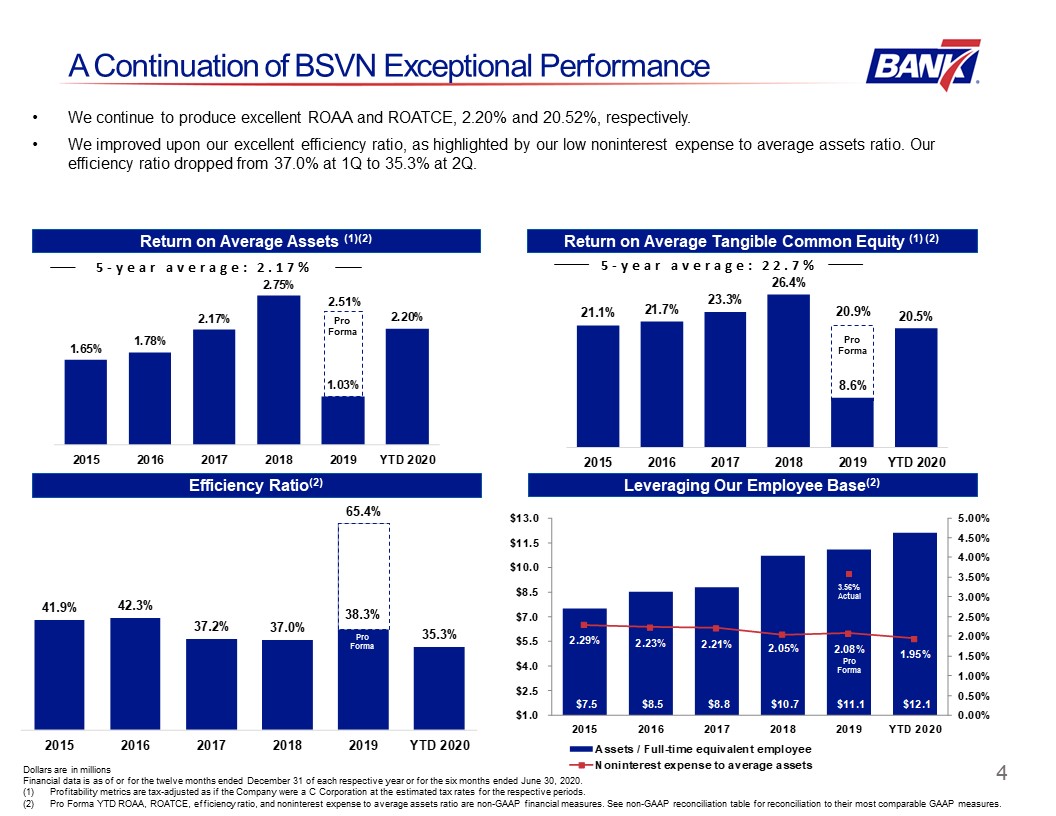
A Continuation of BSVN Exceptional Performance Return on Average Assets (1)(2) Return on Average
Tangible Common Equity (1) (2) Dollars are in millionsFinancial data is as of or for the twelve months ended December 31 of each respective year or for the six months ended June 30, 2020.Profitability metrics are tax-adjusted as if the
Company were a C Corporation at the estimated tax rates for the respective periods. Pro Forma YTD ROAA, ROATCE, efficiency ratio, and noninterest expense to average assets ratio are non-GAAP financial measures. See non-GAAP reconciliation
table for reconciliation to their most comparable GAAP measures. Leveraging Our Employee Base(2) Efficiency Ratio(2) We continue to produce excellent ROAA and ROATCE, 2.20% and 20.52%, respectively. We improved upon our excellent
efficiency ratio, as highlighted by our low noninterest expense to average assets ratio. Our efficiency ratio dropped from 37.0% at 1Q to 35.3% at 2Q. 4 5-year average: 2.17% 5-year average: 22.7% Pro Forma Pro Forma Pro Forma Pro
Forma 38.3% 2.51% 20.9% 3.56%Actual
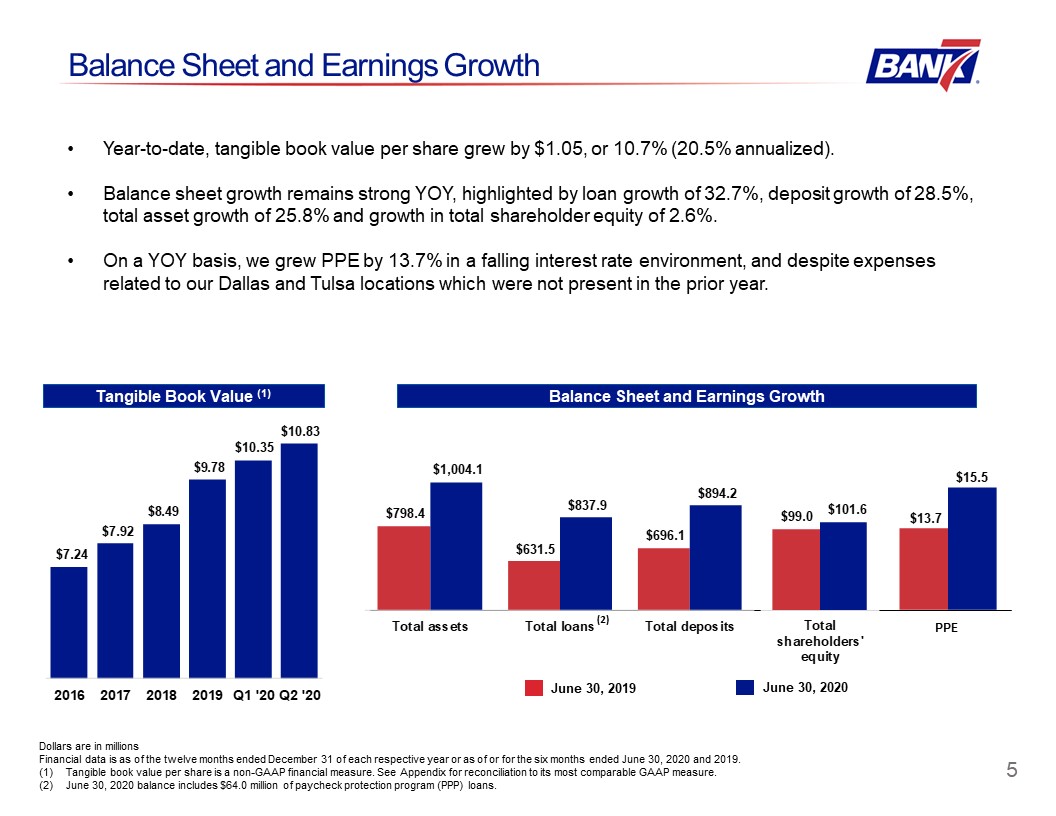
PPE June 30, 2019 June 30, 2020 Balance Sheet and Earnings Growth Dollars are in
millionsFinancial data is as of the twelve months ended December 31 of each respective year or as of or for the six months ended June 30, 2020 and 2019. Tangible book value per share is a non-GAAP financial measure. See Appendix for
reconciliation to its most comparable GAAP measure.June 30, 2020 balance includes $64.0 million of paycheck protection program (PPP) loans. Balance Sheet and Earnings Growth Tangible Book Value (1) Year-to-date, tangible book value per
share grew by $1.05, or 10.7% (20.5% annualized). Balance sheet growth remains strong YOY, highlighted by loan growth of 32.7%, deposit growth of 28.5%, total asset growth of 25.8% and growth in total shareholder equity of 2.6%.On a YOY
basis, we grew PPE by 13.7% in a falling interest rate environment, and despite expenses related to our Dallas and Tulsa locations which were not present in the prior year. 5 (2)
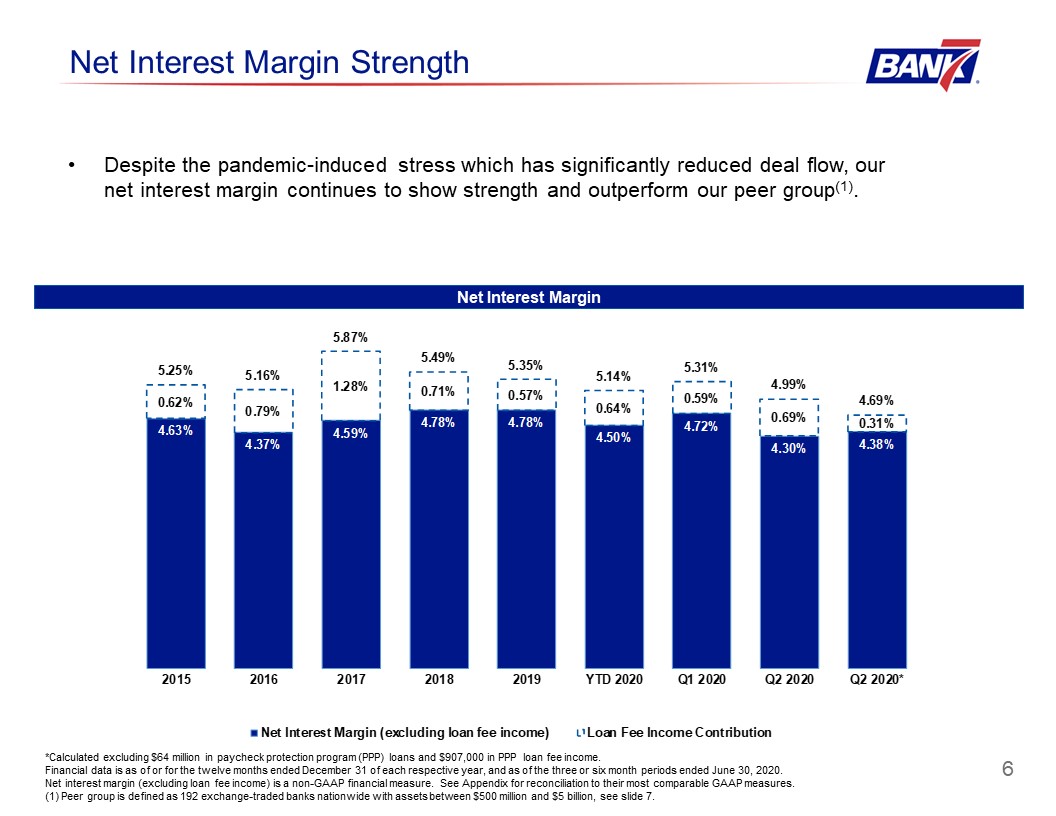
Net Interest Margin Strength *Calculated excluding $64 million in paycheck protection program (PPP)
loans and $907,000 in PPP loan fee income.Financial data is as of or for the twelve months ended December 31 of each respective year, and as of the three or six month periods ended June 30, 2020.Net interest margin (excluding loan fee income)
is a non-GAAP financial measure. See Appendix for reconciliation to their most comparable GAAP measures.(1) Peer group is defined as 192 exchange-traded banks nationwide with assets between $500 million and $5 billion, see slide 7. Net
Interest Margin Despite the pandemic-induced stress which has significantly reduced deal flow, our net interest margin continues to show strength and outperform our peer group(1). 6
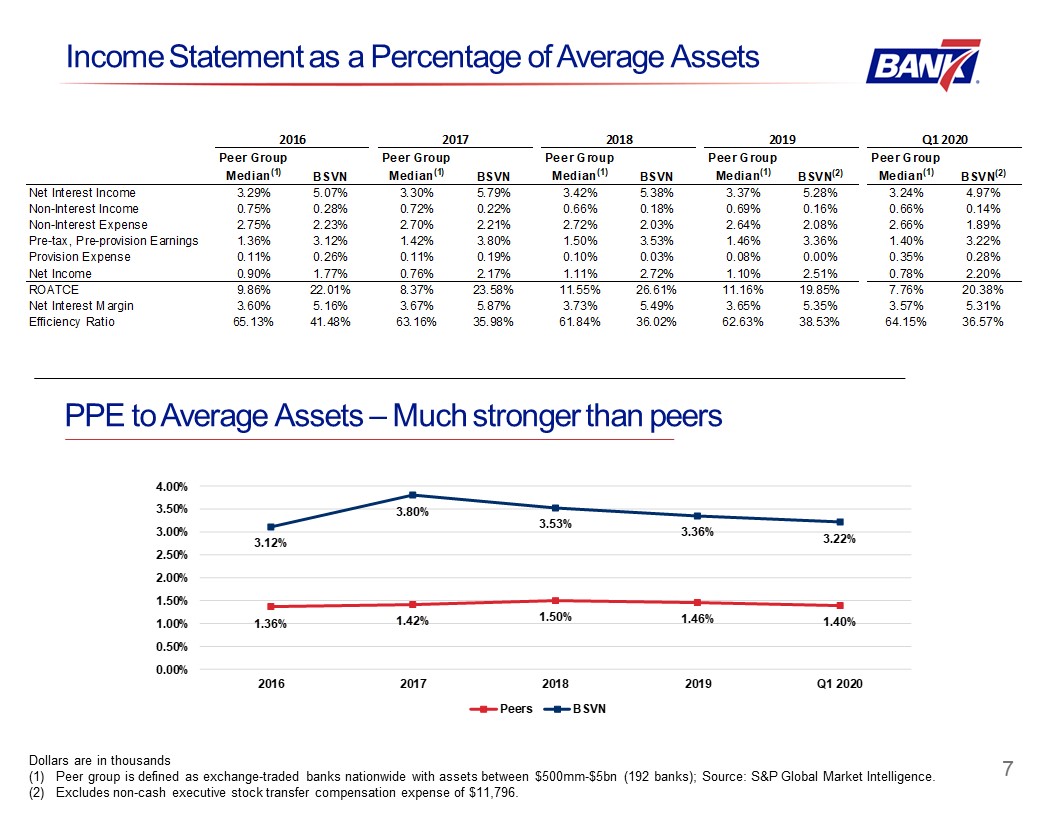
7 Income Statement as a Percentage of Average Assets Dollars are in thousandsPeer group is defined as
exchange-traded banks nationwide with assets between $500mm-$5bn (192 banks); Source: S&P Global Market Intelligence.Excludes non-cash executive stock transfer compensation expense of $11,796. PPE to Average Assets – Much stronger than
peers
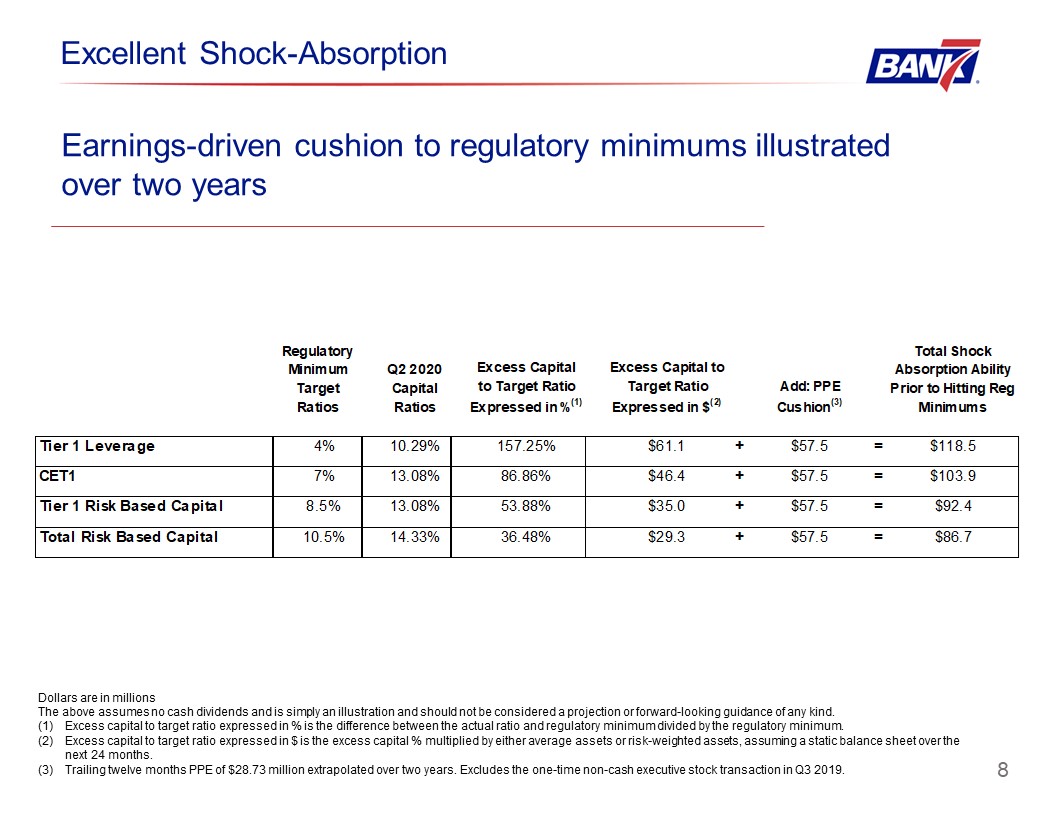
8 Earnings-driven cushion to regulatory minimums illustrated over two years Dollars are in
millionsThe above assumes no cash dividends and is simply an illustration and should not be considered a projection or forward-looking guidance of any kind. Excess capital to target ratio expressed in % is the difference between the actual
ratio and regulatory minimum divided by the regulatory minimum.Excess capital to target ratio expressed in $ is the excess capital % multiplied by either average assets or risk-weighted assets, assuming a static balance sheet over the next 24
months. Trailing twelve months PPE of $28.73 million extrapolated over two years. Excludes the one-time non-cash executive stock transaction in Q3 2019. Excellent Shock-Absorption
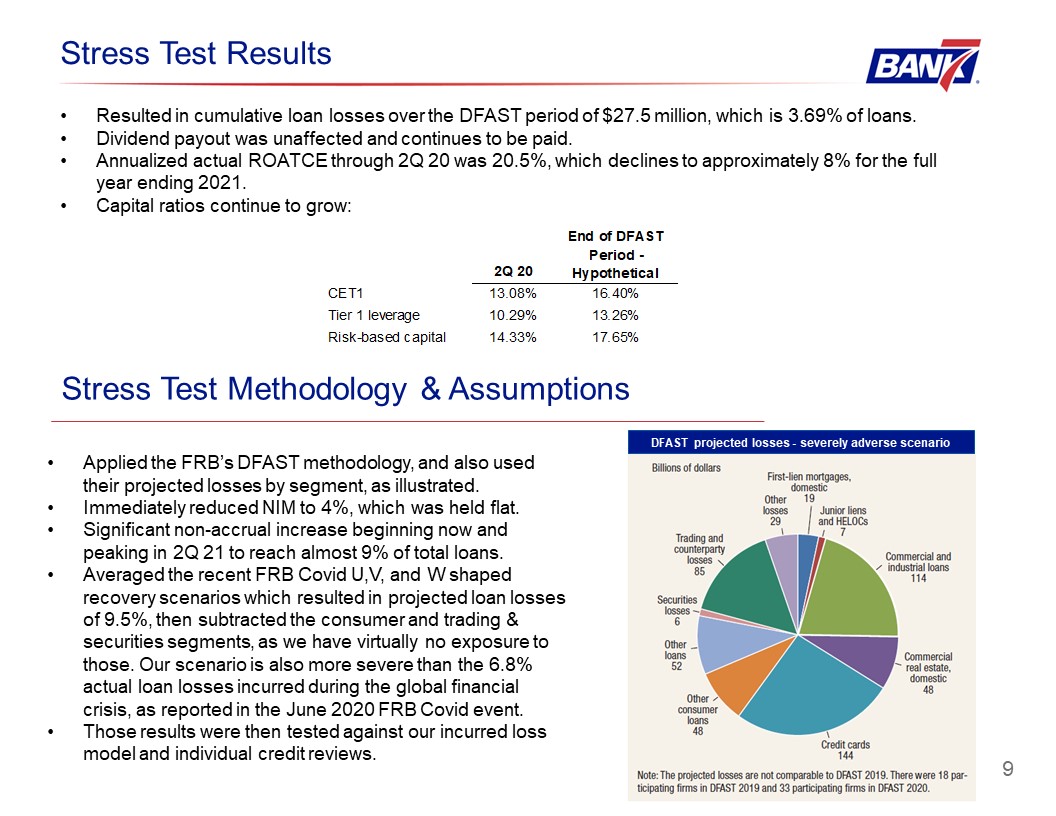
9 Stress Test Methodology & Assumptions Stress Test Results Resulted in cumulative loan losses
over the DFAST period of $27.5 million, which is 3.69% of loans.Dividend payout was unaffected and continues to be paid. Annualized actual ROATCE through 2Q 20 was 20.5%, which declines to approximately 8% for the full year ending
2021.Capital ratios continue to grow: Applied the FRB’s DFAST methodology, and also used their projected losses by segment, as illustrated.Immediately reduced NIM to 4%, which was held flat.Significant non-accrual increase beginning now and
peaking in 2Q 21 to reach almost 9% of total loans.Averaged the recent FRB Covid U,V, and W shaped recovery scenarios which resulted in projected loan losses of 9.5%, then subtracted the consumer and trading & securities segments, as we
have virtually no exposure to those. Our scenario is also more severe than the 6.8% actual loan losses incurred during the global financial crisis, as reported in the June 2020 FRB Covid event. Those results were then tested against our
incurred loss model and individual credit reviews. DFAST projected losses - severely adverse scenario
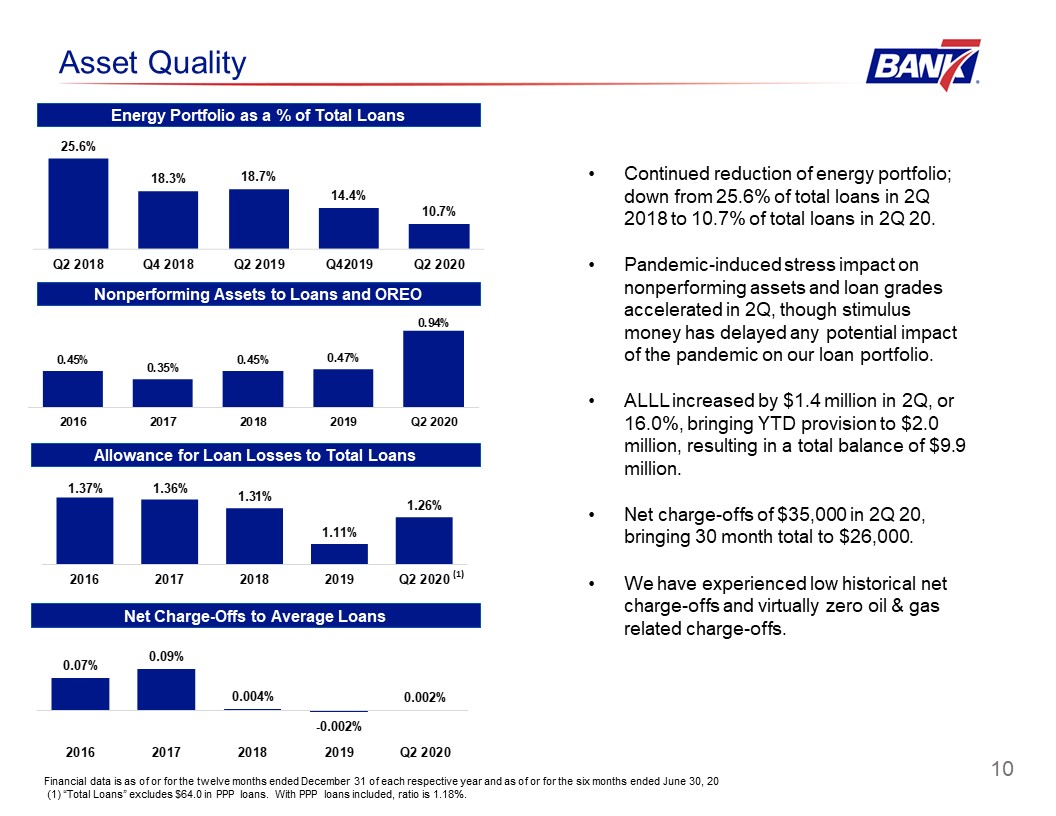
10 Allowance for Loan Losses to Total Loans Nonperforming Assets to Loans and OREO Asset
Quality Net Charge-Offs to Average Loans Financial data is as of or for the twelve months ended December 31 of each respective year and as of or for the six months ended June 30, 2020. (1) “Total Loans” excludes $64.0 in PPP loans. With PPP
loans included, ratio is 1.18%. Continued reduction of energy portfolio; down from 25.6% of total loans in 2Q 2018 to 10.7% of total loans in 2Q 20.Pandemic-induced stress impact on nonperforming assets and loan grades accelerated in 2Q,
though stimulus money has delayed any potential impact of the pandemic on our loan portfolio. ALLL increased by $1.4 million in 2Q, or 16.0%, bringing YTD provision to $2.0 million, resulting in a total balance of $9.9 million.Net charge-offs
of $35,000 in 2Q 20, bringing 30 month total to $26,000.We have experienced low historical net charge-offs and virtually zero oil & gas related charge-offs. (1) Energy Portfolio as a % of Total Loans
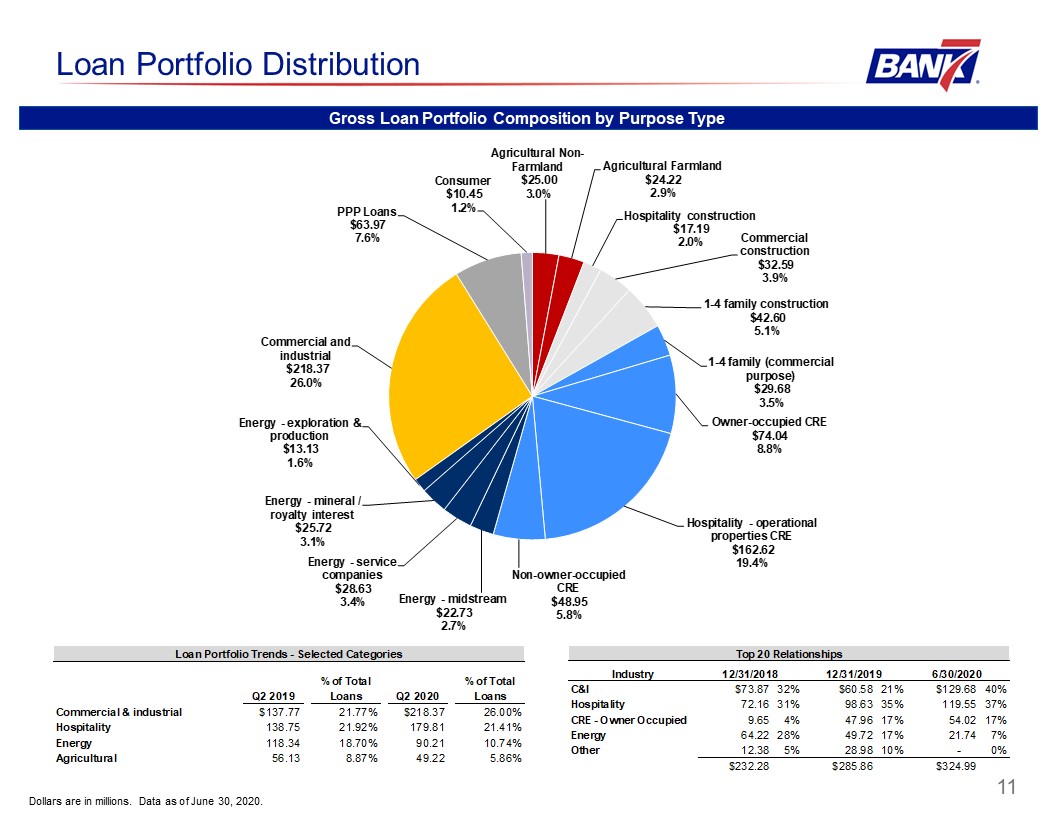
Loan Portfolio Distribution Dollars are in millions. Data as of June 30, 2020. Gross Loan Portfolio
Composition by Purpose Type 11
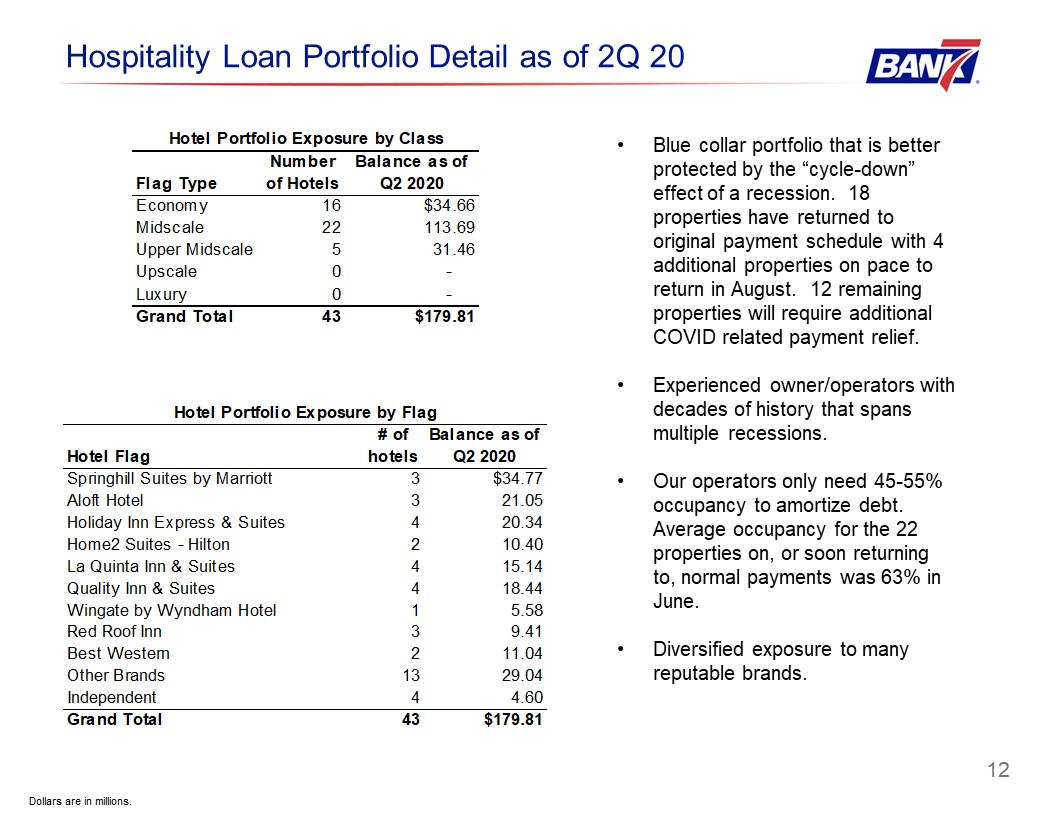
Hospitality Loan Portfolio Detail as of 2Q 20 12 Blue collar portfolio that is better protected by
the “cycle-down” effect of a recession. 18 properties have returned to original payment schedule with 4 additional properties on pace to return in August. 12 remaining properties will require additional COVID related payment
relief.Experienced owner/operators with decades of history that spans multiple recessions. Our operators only need 45-55% occupancy to amortize debt. Average occupancy for the 22 properties on, or soon returning to, normal payments was 63% in
June.Diversified exposure to many reputable brands. Dollars are in millions.
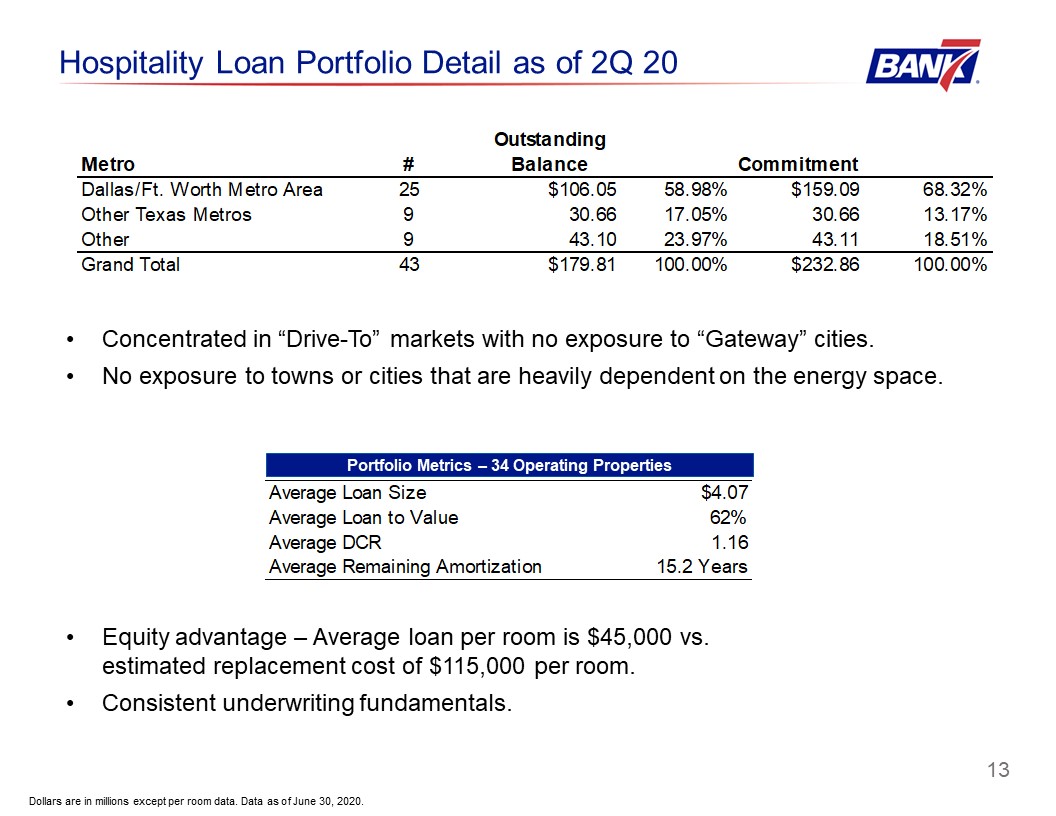
13 Hospitality Loan Portfolio Detail as of 2Q 20 Equity advantage – Average loan per room is $45,000
vs. estimated replacement cost of $115,000 per room.Consistent underwriting fundamentals. Concentrated in “Drive-To” markets with no exposure to “Gateway” cities.No exposure to towns or cities that are heavily dependent on the energy
space. Portfolio Metrics – 34 Operating Properties Dollars are in millions except per room data. Data as of June 30, 2020.
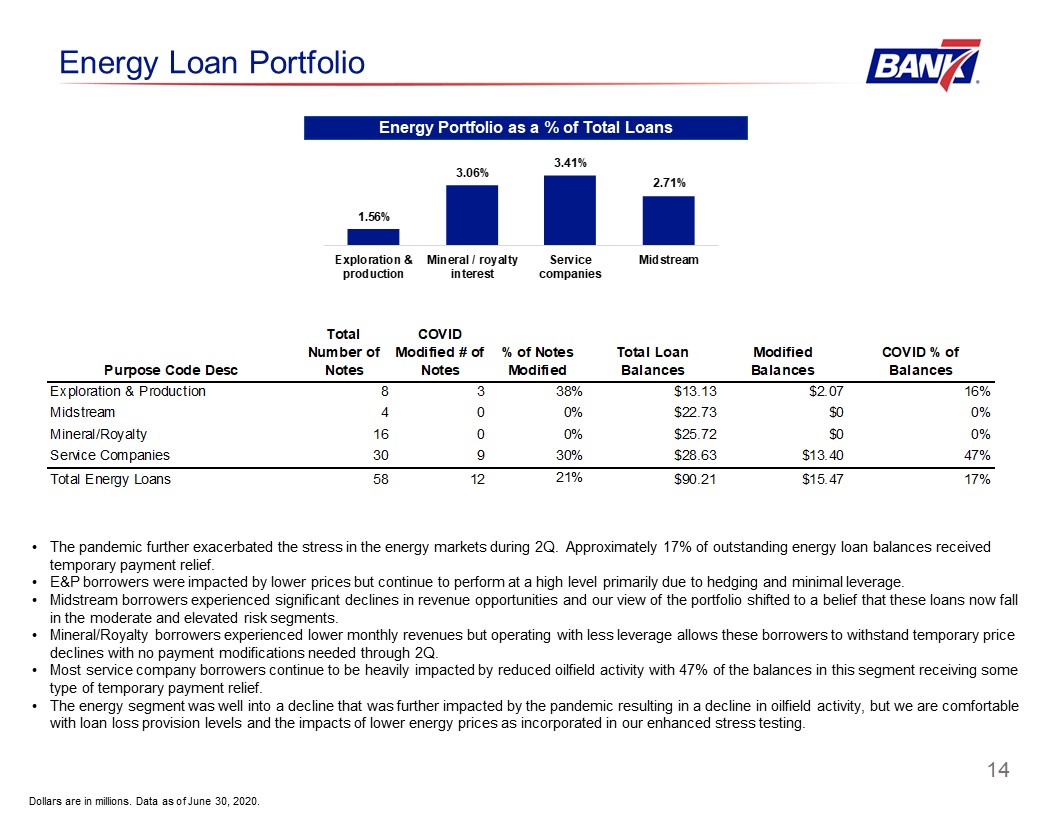
14 Dollars are in millions. Data as of June 30, 2020. Energy Loan Portfolio Energy Portfolio as a %
of Total Loans The pandemic further exacerbated the stress in the energy markets during 2Q. Approximately 17% of outstanding energy loan balances received temporary payment relief.E&P borrowers were impacted by lower prices but continue
to perform at a high level primarily due to hedging and minimal leverage.Midstream borrowers experienced significant declines in revenue opportunities and our view of the portfolio shifted to a belief that these loans now fall in the moderate
and elevated risk segments.Mineral/Royalty borrowers experienced lower monthly revenues but operating with less leverage allows these borrowers to withstand temporary price declines with no payment modifications needed through 2Q.Most service
company borrowers continue to be heavily impacted by reduced oilfield activity with 47% of the balances in this segment receiving some type of temporary payment relief.The energy segment was well into a decline that was further impacted by
the pandemic resulting in a decline in oilfield activity, but we are comfortable with loan loss provision levels and the impacts of lower energy prices as incorporated in our enhanced stress testing.
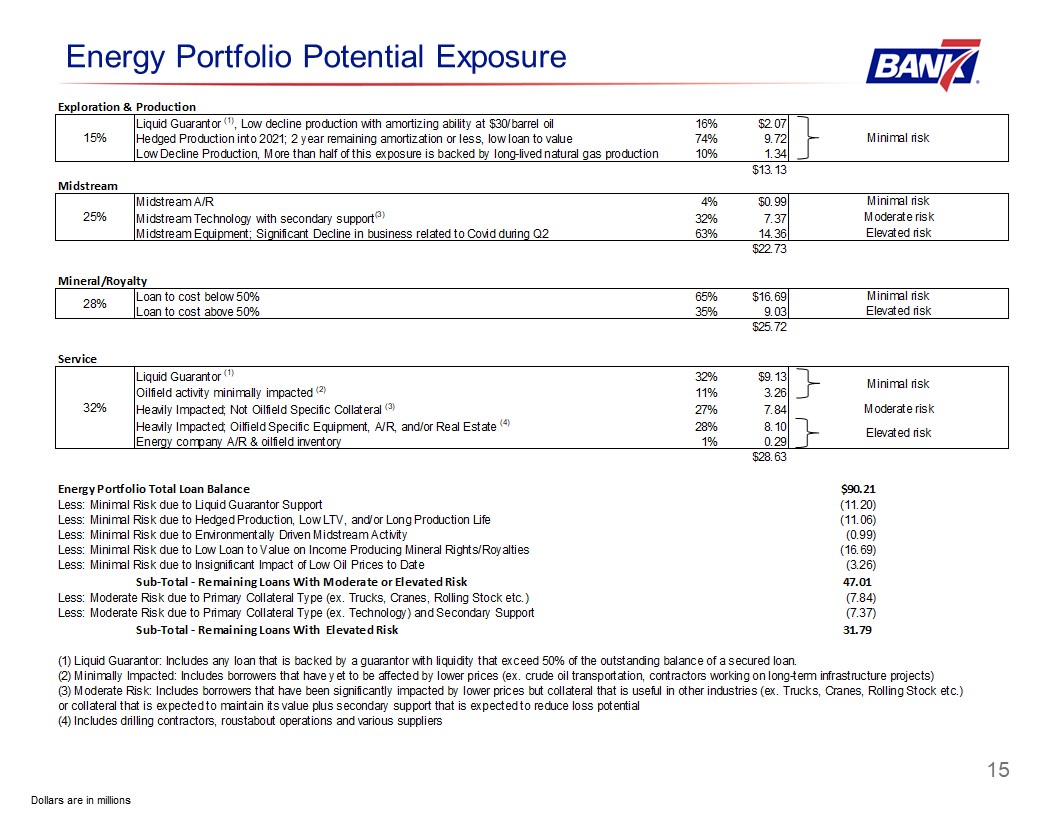
Dollars are in millions Energy Portfolio Potential Exposure 15
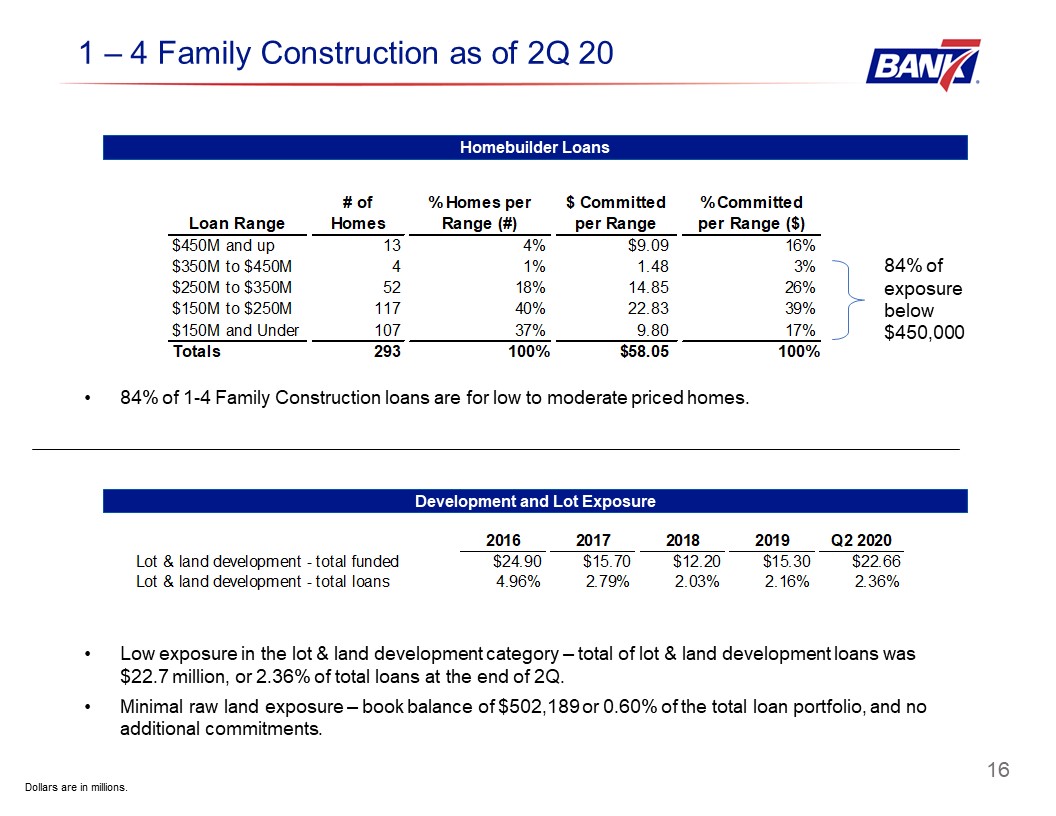
16 Development and Lot Exposure Low exposure in the lot & land development category – total of
lot & land development loans was $22.7 million, or 2.36% of total loans at the end of 2Q.Minimal raw land exposure – book balance of $502,189 or 0.60% of the total loan portfolio, and no additional commitments. Dollars are in
millions. 1 – 4 Family Construction as of 2Q 20 84% of exposure below $450,000 Homebuilder Loans 84% of 1-4 Family Construction loans are for low to moderate priced homes.
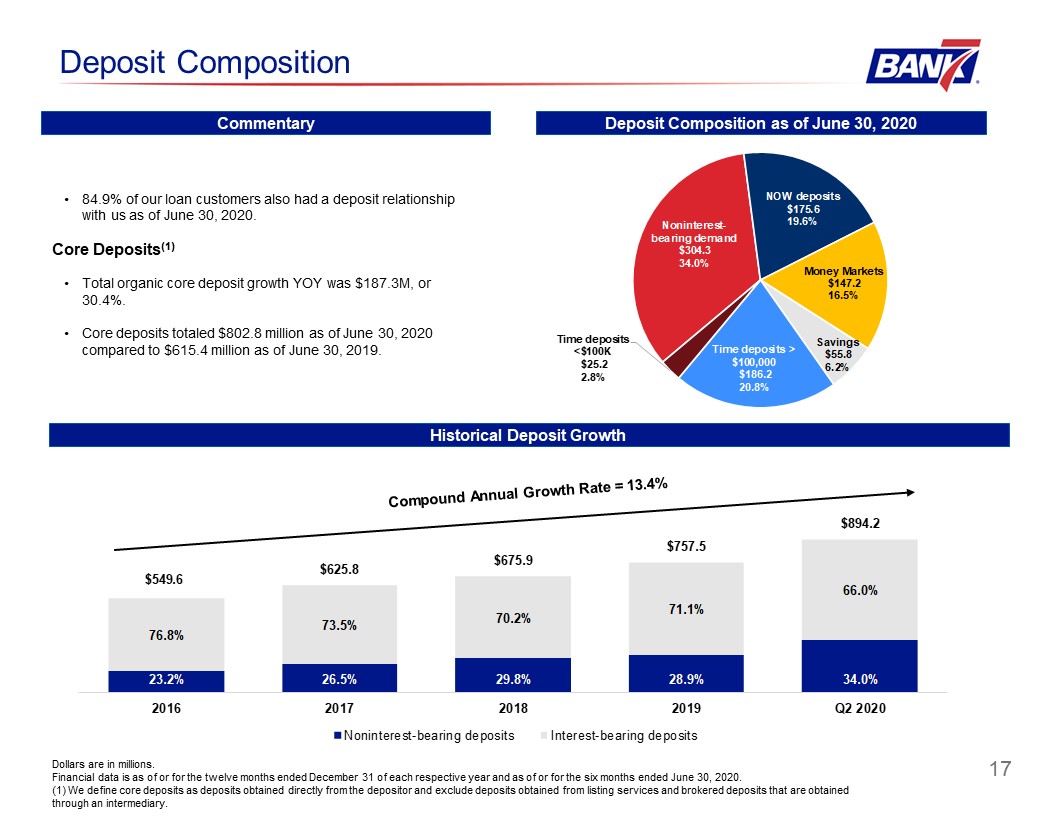
Deposit Composition Historical Deposit Growth Compound Annual Growth Rate = 13.4% Deposit
Composition as of June 30, 2020 84.9% of our loan customers also had a deposit relationship with us as of June 30, 2020.Core Deposits(1)Total organic core deposit growth YOY was $187.3M, or 30.4%. Core deposits totaled $802.8 million as of
June 30, 2020 compared to $615.4 million as of June 30, 2019. Dollars are in millions.Financial data is as of or for the twelve months ended December 31 of each respective year and as of or for the six months ended June 30, 2020.(1) We
define core deposits as deposits obtained directly from the depositor and exclude deposits obtained from listing services and brokered deposits that are obtained through an intermediary. 28.4% 26.3% Commentary 17
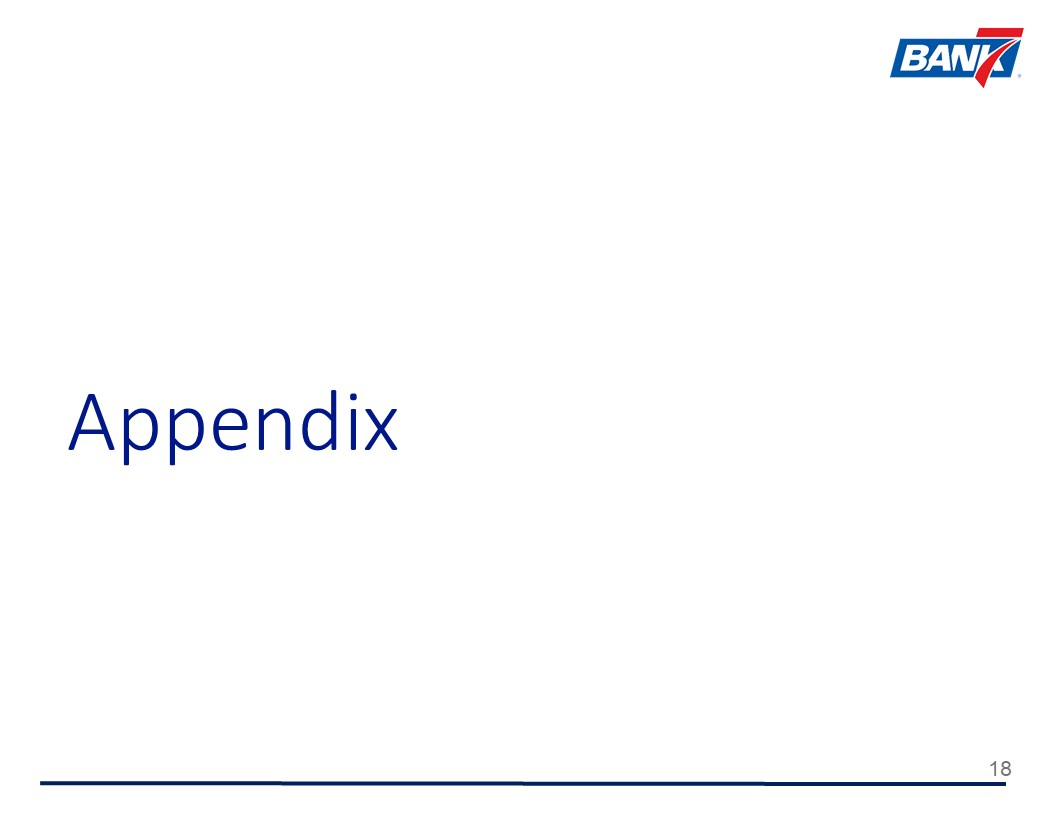
Appendix 18
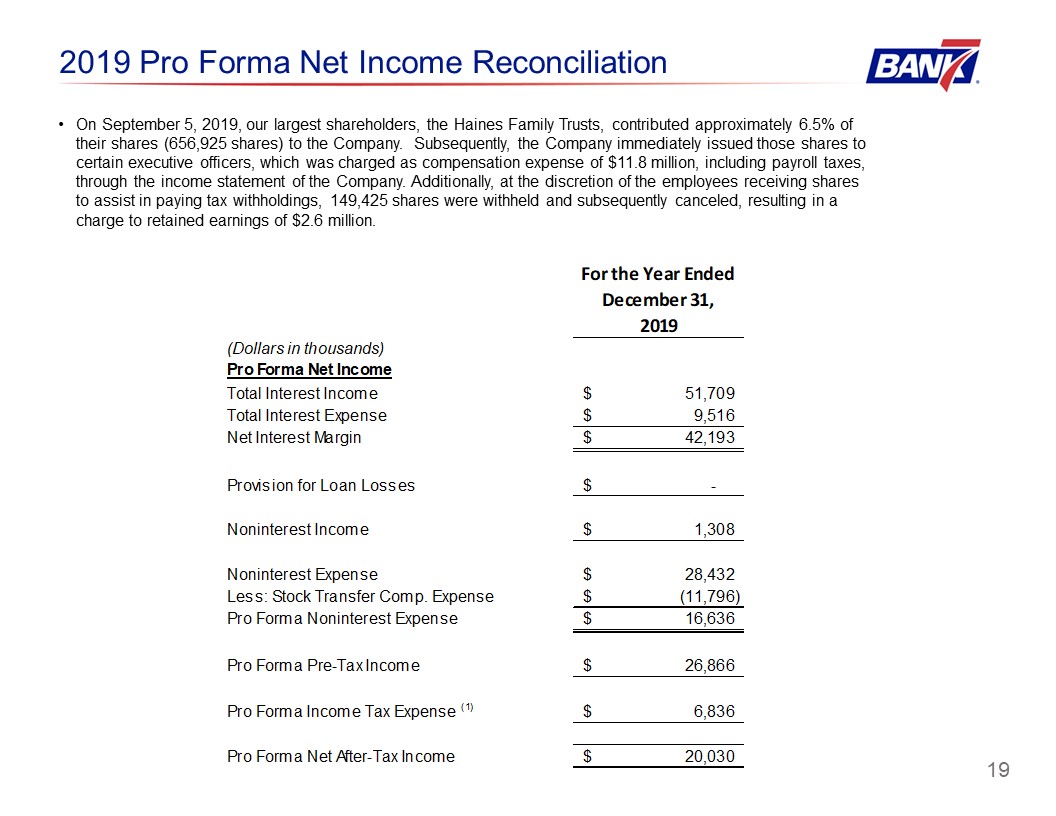
19 2019 Pro Forma Net Income Reconciliation On September 5, 2019, our largest shareholders, the
Haines Family Trusts, contributed approximately 6.5% of their shares (656,925 shares) to the Company. Subsequently, the Company immediately issued those shares to certain executive officers, which was charged as compensation expense of $11.8
million, including payroll taxes, through the income statement of the Company. Additionally, at the discretion of the employees receiving shares to assist in paying tax withholdings, 149,425 shares were withheld and subsequently canceled,
resulting in a charge to retained earnings of $2.6 million.
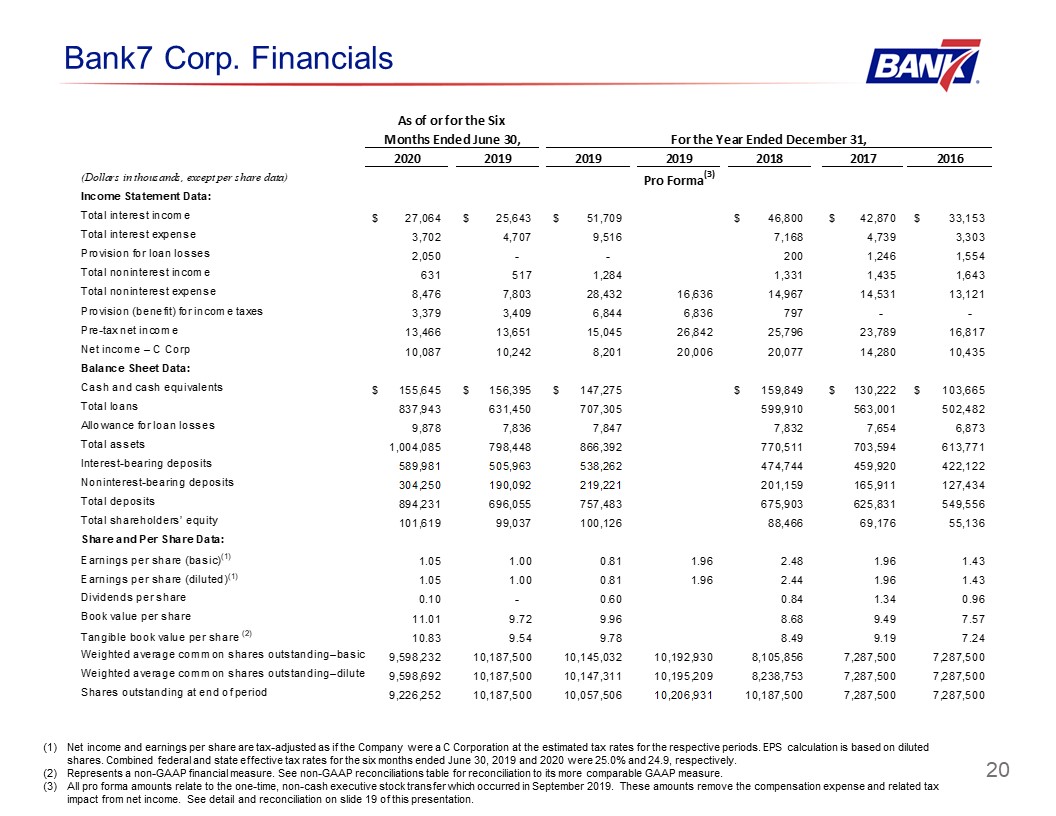
20 Bank7 Corp. Financials Net income and earnings per share are tax-adjusted as if the Company were a
C Corporation at the estimated tax rates for the respective periods. EPS calculation is based on diluted shares. Combined federal and state effective tax rates for the six months ended June 30, 2019 and 2020 were 25.0% and 24.9, respectively.
Represents a non-GAAP financial measure. See non-GAAP reconciliations table for reconciliation to its more comparable GAAP measure. All pro forma amounts relate to the one-time, non-cash executive stock transfer which occurred in September
2019. These amounts remove the compensation expense and related tax impact from net income. See detail and reconciliation on slide 19 of this presentation.
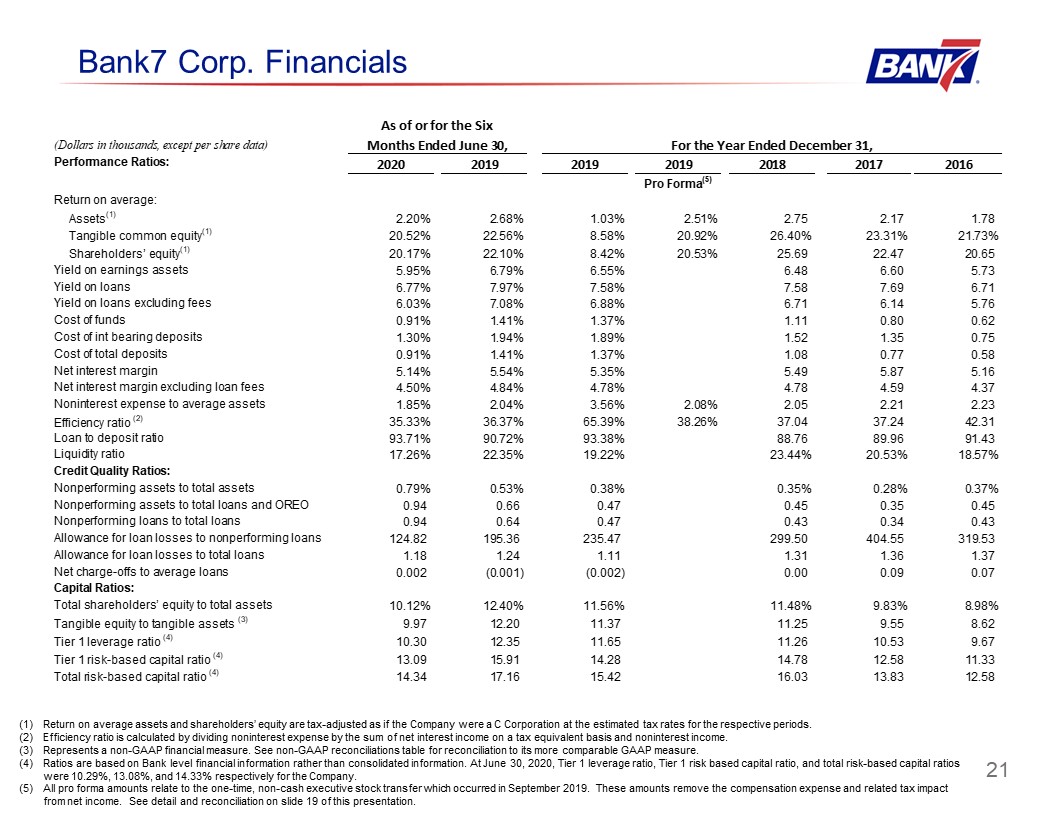
21 Bank7 Corp. Financials Return on average assets and shareholders’ equity are tax-adjusted as if
the Company were a C Corporation at the estimated tax rates for the respective periods.Efficiency ratio is calculated by dividing noninterest expense by the sum of net interest income on a tax equivalent basis and noninterest income.
Represents a non-GAAP financial measure. See non-GAAP reconciliations table for reconciliation to its more comparable GAAP measure. Ratios are based on Bank level financial information rather than consolidated information. At June 30, 2020,
Tier 1 leverage ratio, Tier 1 risk based capital ratio, and total risk-based capital ratios were 10.29%, 13.08%, and 14.33% respectively for the Company.All pro forma amounts relate to the one-time, non-cash executive stock transfer which
occurred in September 2019. These amounts remove the compensation expense and related tax impact from net income. See detail and reconciliation on slide 19 of this presentation.
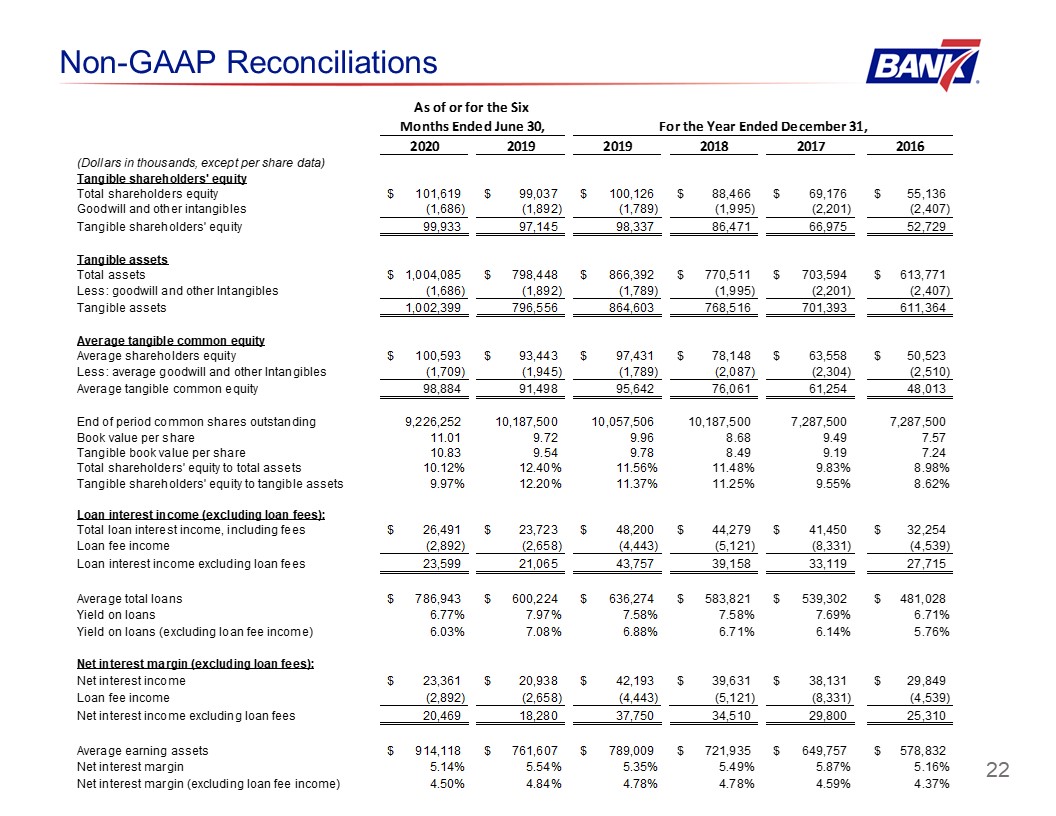
22 Non-GAAP Reconciliations
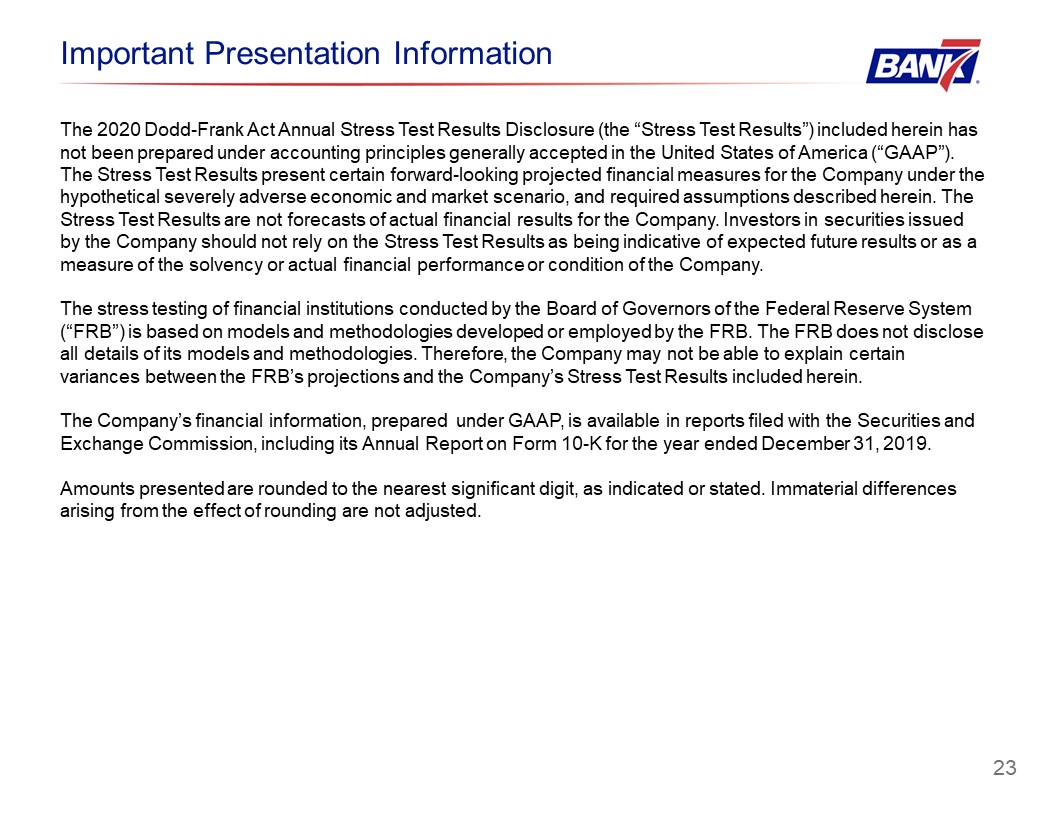
23 Important Presentation Information The 2020 Dodd-Frank Act Annual Stress Test Results Disclosure
(the “Stress Test Results”) included herein has not been prepared under accounting principles generally accepted in the United States of America (“GAAP”). The Stress Test Results present certain forward-looking projected financial measures
for the Company under the hypothetical severely adverse economic and market scenario, and required assumptions described herein. The Stress Test Results are not forecasts of actual financial results for the Company. Investors in securities
issued by the Company should not rely on the Stress Test Results as being indicative of expected future results or as a measure of the solvency or actual financial performance or condition of the Company. The stress testing of financial
institutions conducted by the Board of Governors of the Federal Reserve System (“FRB”) is based on models and methodologies developed or employed by the FRB. The FRB does not disclose all details of its models and methodologies. Therefore,
the Company may not be able to explain certain variances between the FRB’s projections and the Company’s Stress Test Results included herein.The Company’s financial information, prepared under GAAP, is available in reports filed with the
Securities and Exchange Commission, including its Annual Report on Form 10-K for the year ended December 31, 2019.Amounts presented are rounded to the nearest significant digit, as indicated or stated. Immaterial differences arising from the
effect of rounding are not adjusted.
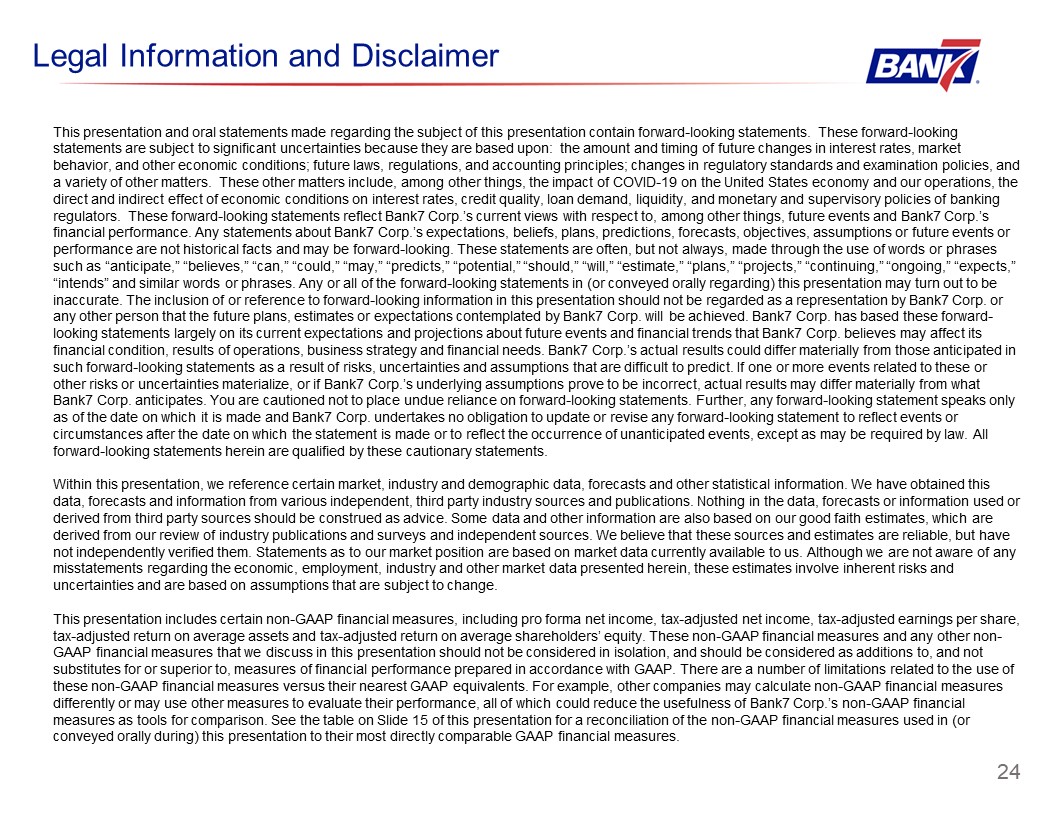
24 Legal Information and Disclaimer This presentation and oral statements made regarding the subject
of this presentation contain forward-looking statements. These forward-looking statements are subject to significant uncertainties because they are based upon: the amount and timing of future changes in interest rates, market behavior, and
other economic conditions; future laws, regulations, and accounting principles; changes in regulatory standards and examination policies, and a variety of other matters. These other matters include, among other things, the impact of COVID-19
on the United States economy and our operations, the direct and indirect effect of economic conditions on interest rates, credit quality, loan demand, liquidity, and monetary and supervisory policies of banking regulators. These
forward-looking statements reflect Bank7 Corp.’s current views with respect to, among other things, future events and Bank7 Corp.’s financial performance. Any statements about Bank7 Corp.’s expectations, beliefs, plans, predictions,
forecasts, objectives, assumptions or future events or performance are not historical facts and may be forward-looking. These statements are often, but not always, made through the use of words or phrases such as “anticipate,” “believes,”
“can,” “could,” “may,” “predicts,” “potential,” “should,” “will,” “estimate,” “plans,” “projects,” “continuing,” “ongoing,” “expects,” “intends” and similar words or phrases. Any or all of the forward-looking statements in (or conveyed orally
regarding) this presentation may turn out to be inaccurate. The inclusion of or reference to forward-looking information in this presentation should not be regarded as a representation by Bank7 Corp. or any other person that the future plans,
estimates or expectations contemplated by Bank7 Corp. will be achieved. Bank7 Corp. has based these forward-looking statements largely on its current expectations and projections about future events and financial trends that Bank7 Corp.
believes may affect its financial condition, results of operations, business strategy and financial needs. Bank7 Corp.’s actual results could differ materially from those anticipated in such forward-looking statements as a result of risks,
uncertainties and assumptions that are difficult to predict. If one or more events related to these or other risks or uncertainties materialize, or if Bank7 Corp.’s underlying assumptions prove to be incorrect, actual results may differ
materially from what Bank7 Corp. anticipates. You are cautioned not to place undue reliance on forward-looking statements. Further, any forward-looking statement speaks only as of the date on which it is made and Bank7 Corp. undertakes no
obligation to update or revise any forward-looking statement to reflect events or circumstances after the date on which the statement is made or to reflect the occurrence of unanticipated events, except as may be required by law. All
forward-looking statements herein are qualified by these cautionary statements. Within this presentation, we reference certain market, industry and demographic data, forecasts and other statistical information. We have obtained this data,
forecasts and information from various independent, third party industry sources and publications. Nothing in the data, forecasts or information used or derived from third party sources should be construed as advice. Some data and other
information are also based on our good faith estimates, which are derived from our review of industry publications and surveys and independent sources. We believe that these sources and estimates are reliable, but have not independently
verified them. Statements as to our market position are based on market data currently available to us. Although we are not aware of any misstatements regarding the economic, employment, industry and other market data presented herein, these
estimates involve inherent risks and uncertainties and are based on assumptions that are subject to change. This presentation includes certain non-GAAP financial measures, including pro forma net income, tax-adjusted net income, tax-adjusted
earnings per share, tax-adjusted return on average assets and tax-adjusted return on average shareholders’ equity. These non-GAAP financial measures and any other non-GAAP financial measures that we discuss in this presentation should not be
considered in isolation, and should be considered as additions to, and not substitutes for or superior to, measures of financial performance prepared in accordance with GAAP. There are a number of limitations related to the use of these
non-GAAP financial measures versus their nearest GAAP equivalents. For example, other companies may calculate non-GAAP financial measures differently or may use other measures to evaluate their performance, all of which could reduce the
usefulness of Bank7 Corp.’s non-GAAP financial measures as tools for comparison. See the table on Slide 15 of this presentation for a reconciliation of the non-GAAP financial measures used in (or conveyed orally during) this presentation to
their most directly comparable GAAP financial measures.
